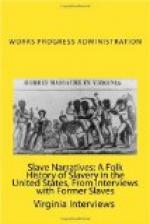I lived on in Natchez. I worked for white folks—cooked for them. I did a lot of traveling. Even went up into Virginia. Traveled most of the time. I’d go with one family and when we’d get back, there’d be another one who wanted me to go and take care of their children.
Been in Hot Springs since 1905. Worked for Dr. —— first. Stayed right in the house. Never did see such fine folks as Dr. ——” (prominent local surgeon) “and his wife. Then I worked for Mr. ——” (prominent realtor) “Yes, and I’s worked at the Army and Navy Hospital too. Mighty nice up there. Worked in the officer’s mess—finest place up there. I’s worked for the officers too. Then I’s worked for the Levi Hospital. Worked for lots of folks.
I’s worked for lots of folks and in lots of places. But I haven’t got anything now. How soon do you think they will begin paying us? I get just $10 from the county every month. $5 of that goes for my house. Folks gives me clothes, but if they’d only give me groceries too, I could get along. When do you think they will begin to pay us?”
Interviewer: Miss Irene Robertson
Person interviewed: Cal Woods; R.F.D., Biscoe,
Arkansas
Age: 85?
“I don’t know zactly how old I is. I was good size boy when the war come on. We all belonged to a man named John Woods. We lived in South Carolina during slavery. Slavery was prutty bad itself but the bad time come after the war. The land was hilly some red and some pore and sandy. Had to plough a mule or horse. Hard to make a living. Some folks was rich, had heap of slaves and some bout one family. Small farmer have 160 acres and one family of slaves. When a man had one or two slave families he treated em better an if he had a great big acreage and fifteen or twenty families. The white folks trained the black man and woman. If he have so many they didn’t learn how to do but one or two things. Mas generally they all worked in the fields in the busy seasons and sometimes the white folks have to work out there too. Sometimes they get in debt and have to sell off some slave to pay the debt.
“Things seemed heap mo plentiful. Before the war folks wore fine clothes. They go to their nearest tradin point and sell cotton. They had fine silk clothes and fine knives and forks. They would buy a whole case o cheese at one time and a barrel of molasses. Folks eat more and worked harder than they do now.
“Some folks was mean to their slaves and some slaves mean. It is lack it is now, some folks good no matter what dey color, other folks bad. Black folks never knowed there was freedom till they was fighting and going to war. Some say they was fightin to save their slaves, some say the Union broke. The slave never been free since he come to dis world, didn’t know nuthin bout freedom till they tole em bout it.




